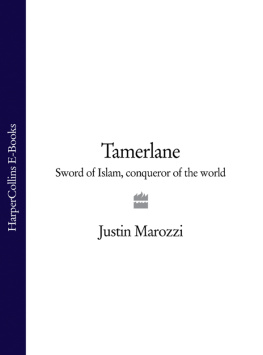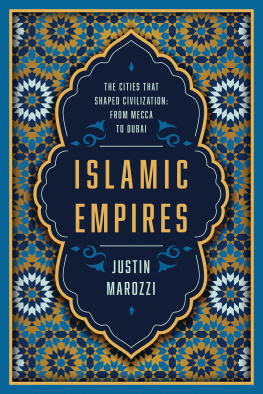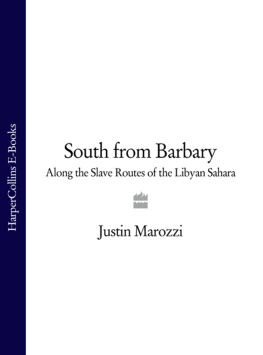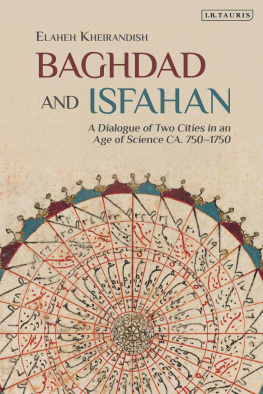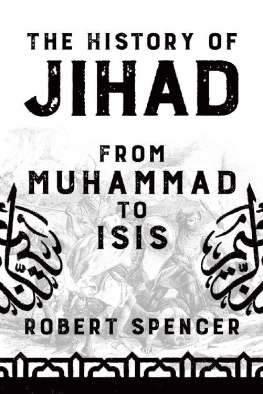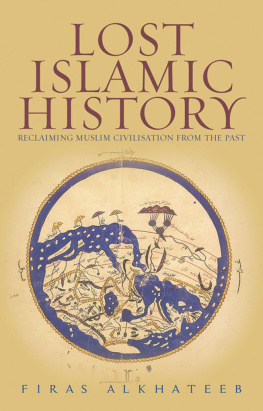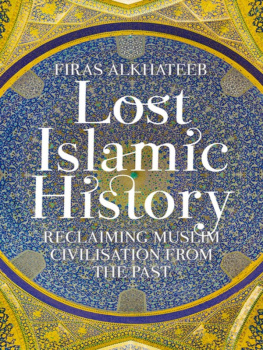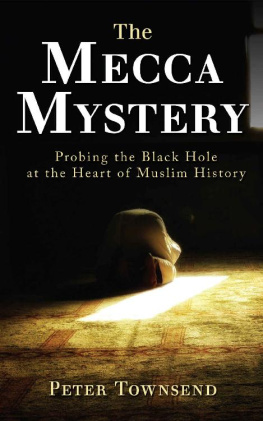
Justin Marozzi
ISLAMIC EMPIRES
Fifteen Cities that Define a Civilization

Contents
About the Author
Justin Marozzi has spent most of his professional life living and working in the Muslim world, with long assignments in Iraq, Libya, Afghanistan, Pakistan, Egypt, Morocco, Tunisia, Syria, Lebanon and Somalia. He is a former Trustee of the Royal Geographical Society and a Senior Research Fellow in Journalism and the Popular Understanding of History at Buckingham University. His previous books include South from Barbary: Along the Slave Routes of the Libyan Sahara (2001), the bestselling Tamerlane: Sword of Islam, Conqueror of the World (2004) and The Man Who Invented History: Travels with Herodotus (2008). His last book, Baghdad: City of Peace, City of Blood (2014) won the Royal Society of Literatures Ondaatje Prize and was praised by the judges as a truly monumental achievement.
To J
I could not have done it without you
List of Illustrations
Photographic acknowledgements are given in parentheses.
. Mecca in Arabia, Dutch print, seventeenth century. (Trustees of the British Museum)
. The Great Mosque, Mecca, Saudi Arabia. (Samareen/Shutterstock)
. The Umayyad Mosque, Damascus, Syria. (Marko Stavric/Getty Images)
. Arbin, Damascus, 2018. (Anadolu/Getty Images)
. Scholars at an Abbasid library in Baghdad, illustration by Yahyal-Wasiti from the Al-Maqamat by Abu Mohammed al Qasim ibn Ali al-Hariri, thirteenth century. (Copyright Bibliotheque Nationale, France)
. View from the Mustansiriya University, Baghdad, Iraq. (Homo-Cosmicos/Alamy)
. The Mezquita-Catedral, Cordoba. (Andrey Lebedev/Shutterstock)
. Interior of the Mezquita, Cordoba. (Botond Horvath/Shutterstock)
. The Medinat al Zahra, near Cordoba. (Justin Marozzi)
. The Taking of Jerusalem by the Crusaders on 15 July 1099, painting by Emile Signol, 1847. (Christophel Fine Art /UIG via Getty Images)
. Jerusalem, Israel. (Meunierd/Shutterstock)
. The Saladin citadel in Cairo, Egypt, with the Mosque of Mohammed Ali on the left, c. 1920. (Popperfoto/Getty Images)
. Maimonides draft of his legal code in Sephardic script, written in Egypt c. 1180. (Corbis/Getty Images)
. Solomon Schechter studying the Geniza documents, Cambridge, c. 1898. (Culture Club/Getty Images)
. Bab Bou Jeloud gate, Fez, Morocco. (Getty Images/Jeronimo Alba)
. Chaouara leather tannery in Fez, Morocco. (Robert Harding/Alamy)
. Timur receiving a European embassy and the son of Sultan Murad I, Persian miniature, 1529. (Interfoto/Alamy)
. The Sher Dor Madrassa, Samarkand, Uzbekistan. (Dinozzzaver/Shutterstock)
. Gur Amir Mausoleum, Samarkand. (Lukas Bischoff/istockphoto)
. Sultan Mehmed II, portrait by Gentile Bellini, 1480. (World History Archive/Alamy)
. The Hagia Sophia, Istanbul, Turkey. (Justin Marozzi)
. Aerial view of Istanbul. (Ugurhan/istockphoto)
. Babur supervising the laying out of the Garden of Fidelity, illustration by Nanha to Bishndas Baburnama, Mughal, c. 1590 (Victoria & Albert Museum, London/Bridgeman Images)
. Caretaker at the tomb of Emperor Babur in Kabul, Afghanistan, 2002. (Indranil Mukherjeea/FP/Getty Images)
. US helicopters flying over Kabul, 2011. (Shah Marai/AFP/Getty Images)
. Shah Abbas I, Mughal miniature, Iran, eighteenth century. (Victoria & Albert Museum, London/Alamy)
. Sheikh Lotfollah Mosque, Isfahan, Iran. (Mariusz Prusaczyk/istockphoto)
. View of the Masjid-e Shah, Isfahan, by Pascal Coste, 1840. (Wikimedia Creative Commons)
. Commodore Edward Prebles fleet attacking Tripoli, Libya, 1804. Lithograph, 1846, by Nathaniel Currier. (Granger/Rex/ Shutterstock)
. Boy in Tripoli, during the Libyan revolution, 2011. (Justin Marozzi)
. The Old City, Tripoli. (Justin Marozzi)
. The city of Beirut at the foot of Mount Lebanon. Coloured engraving, English, 1860. (Granger/Bridgeman Images)
. Christian militia, Beirut, Lebanon, 1976. (Copyright Ferdinando Scianna/Magnum Photos)
. Boats in Dubai Creek, United Arab Emirates, 1975. (Helene Rogers/Art Directors & TRIP/Alamy)
. Sheikh Zayed Road, Dubai. (Marianna Ianovska/Shutterstock)
. Skyline of Doha, Qatar. (Danefromspain/istockphoto)
. West Bay, Doha. (Massimo Borchi/4Corners)
List of Maps
Many of these maps draw data copyright to OpenStreetMap contributors, available under the Open Database Licence. The ancient city of Mecca () is not mapped.


A Note on Spelling
Is it to be Mohammed, Muhammad or Mahomet? Should it be the Quran, Koran or Quran? Transliterating Arabic is fraught with danger, and can be a pedants paradise. There are various systems for precise Arabic transliteration, but they are generally very complicated and have little to recommend them aesthetically. My aim has been to make things as simple and comprehensible as possible for the general reader. I do not wish to throw diacritical marks all over the text like confetti, a dot beneath an s and an h here, a line above an i or an a there, apostrophes and hyphens crowding in like unwelcome visitors. Asked to choose between Trkh al-Irq bayna Itillayn (Abbas al Azzawis History of Iraq Between Two Occupations) and Tarikh al Iraq bayn al Ihtilayn, I choose the latter without hesitation.
I have transliterated the guttural Arabic letter qaf or as q, rather than k unlike in my last book, where I did the opposite, so am already guilty of inconsistency. I have chosen to ignore altogether the problematic letter ayn or virtually unpronounceable for those who do not know Arabic, and which tends to be variously rendered a, aa or even 3 because what does an apostrophe, or for that matter 3, really mean to the reader who does not know Arabic or the complexities of Arabic pronunciation? Arabic experts will surely know what is meant, and others will hardly notice its absence. So the caliph Mamun becomes simply Mamun and Iraq becomes Iraq. I prefer not to hyphenate the definite article, so I have Al Mansur and Al Amin rather than Al-Mansur and Al-Amin at the first mention, Mansur and Amin thereafter.
There are, I know, a number of other departures here from the most rigorous modern scholarly practice. Responding to a plea for clarity from the much put-upon editor of Seven Pillars of Wisdom, T. E. Lawrence replied tartly: There are some scientific systems of transliteration, helpful to people who know enough Arabic not to need helping, but a wash-out for the world. I spell my names anyhow, to show what rot the systems are. I would not dream of suggesting these systems are rot, but less brazenly I have followed his example. And, to answer the question with which I began, the Prophet is Mohammed and the holy book revealed to him by Allah is the Quran.
Preface
Im embarrassed to be an Arab these days, a Tunisian friend said to me recently. Everywhere you look theres chaos, fighting, bloodshed, dictatorship, corruption, injustice, unemployment. The only thing were leading the world in is terrorism.
Next page

